 |
June 2020
|
June 2020 // Volume 58 // Number 3 // Ideas at Work // v58-3iw4
Virtual Plant Clinics Cultivate Collaborations and Transfer Knowledge in Extension
Abstract
Plant clinics have been used as a tool to help Extension professionals diagnose crop production problems; however, limited resources have made it difficult to continue to offer in-person clinics. Using distance-learning technology, University of Maryland Extension initiated and offered to Extension professionals "virtual" plant clinics (VPCs) during the 2017 and 2018 growing seasons. Participants reported an increase in knowledge of field conditions across the state and felt that they were more likely to attend a VPC over an in-person clinic. Hosting VPCs is a way for Extension faculty to increase internal communication, share ideas throughout the growing season, and foster collaborations.
Introduction
An Extension educational plant clinic functions as an informal meeting in which relevant parties discuss current agricultural issues related to plant production, pests, and other timely information based on current research findings and field observations. Plant clinics are an important component of production agriculture, have been widely used by Extension in the United States, and have increased in popularity in developing countries (Barnes, 1994; Ausher, Ben-Ze'ev, & Black, 1996). Crop loss to pests varies greatly year to year and spatially but can be as high as 50%–80% (Oerke, 2006). Farmers and agricultural professionals strive to stay ahead of the next crop loss and associated economic disaster (Aycock, 1976). Diagnosing crop pests or disorders is the first step in developing a solution. Participation in plant clinics is one method through which Extension professionals enhance their capacity to diagnose crop production problems.
The role that plant clinics play in Extension and safeguarding of our food supply has been documented (Barnes, 1994; Miller, Beed, & Harmon, 2009). In-person clinics were once common in Extension; however, limited resources have led to the demise of many of these programs. Virtual platforms for education and professional development via the Internet provide Extension professionals a viable solution to these resource limitations (Sobrero & Craycraft, 2008). With remote technology widely available, University of Maryland Extension (UME) developed a virtual plant clinic (VPC) for Extension professionals with the purpose of exchanging knowledge and sharing information concerning growing conditions and crop production in the region. In this article, we describe the methods used for the VPCs, highlight evaluation results, and provide recommendations to assist other institutions in replicating the idea.
VPC Methods
To gauge need and interest via implementation of a pilot version of the program, we hosted VPCs on three dates during Maryland's growing season in 2017. Feedback from participants in 2017 indicated that the VPCs should be expanded to include the early growing season; therefore, monthly VPCs were offered in 2018 from April through September.
These VPCs were developed to be an internal program intended to link Extension faculty and staff from across the state/region; therefore, invitations were restricted to UME agriculture faculty and agriculture faculty from the neighboring institution of University of Delaware Extension. We distributed email invitations prior to the growing season to encourage potential participants to save dates as well as reminder emails 1 week prior to the event. Invitations included a link to a shared Google Drive where VPC participants could upload images for discussion and log-in information for the web-based conferencing program WebEx (Cisco Systems, Inc., San Jose, CA).
Each VPC consisted of roundtable discussions of crop production conditions from across the region, supplemented with pictures and other relevant supporting documents, such as videos and soil test reports, submitted by the participants (see Figure 1). High-quality digital images are an important component of VPCs and are crucial for the success of the program. On average, 33 pictures were shared during each clinic, depicting many different cropping systems. Discussion during the VPCs was facilitated by an Extension faculty member, and topics were predominantly focused on pest issues but also included abiotic disorders and regional Extension programming. Each participant who submitted pictures had the opportunity to explain the associated production situation and exchange conversation with the others in the VPC. Each VPC was recorded and lasted approximately an hour. The recording was uploaded to the shared Google Drive and linked to in a follow-up email for later viewing.
Figure 1.
Screenshot of Shared Documents in Virtual Plant Clinic Google Drive Folder
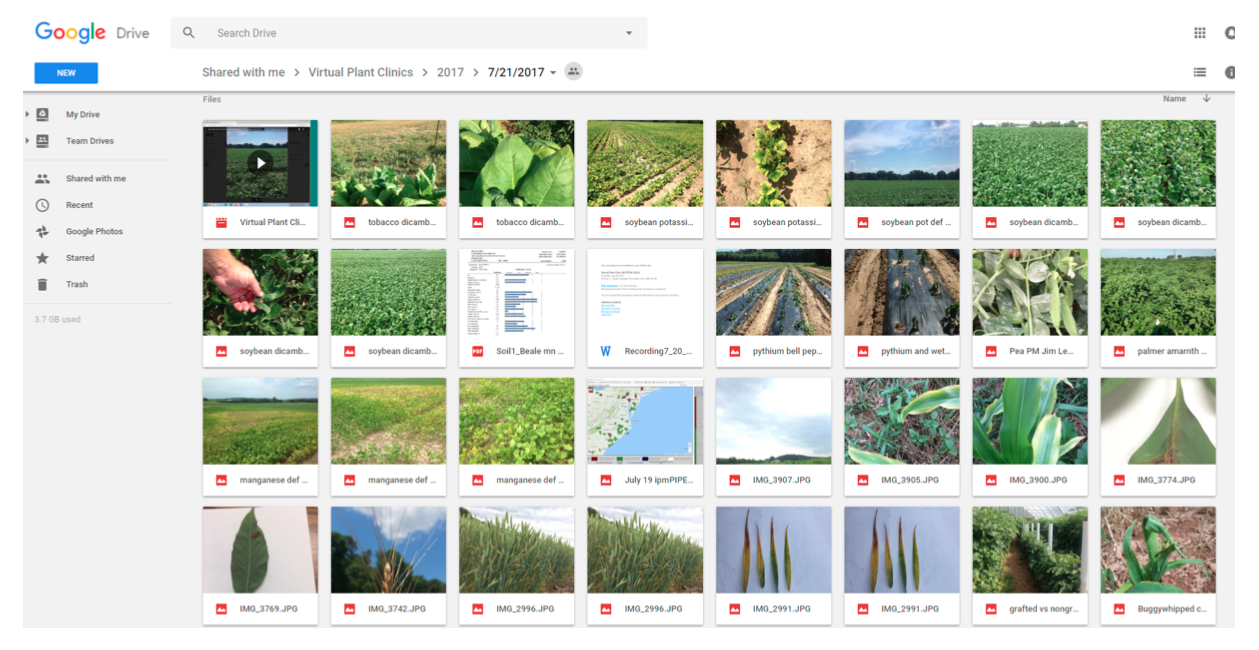
VPC Results and Impact
At the conclusion of each of the 2017 and 2018 seasons, we developed in Qualtrics a web survey with Likert-type questions and distributed it to all participants to evaluate the program. Twenty-two surveys were completed in 2017 and 25 in 2018; demographics were similar in both years (Figure 2). The majority of VPC participants were UME agriculture educators, another large group was Extension specialists, and the remaining participants were faculty from neighboring institutions and other Extension staff members.
Figure 2.
Demographics of Virtual Plant Clinic Participants
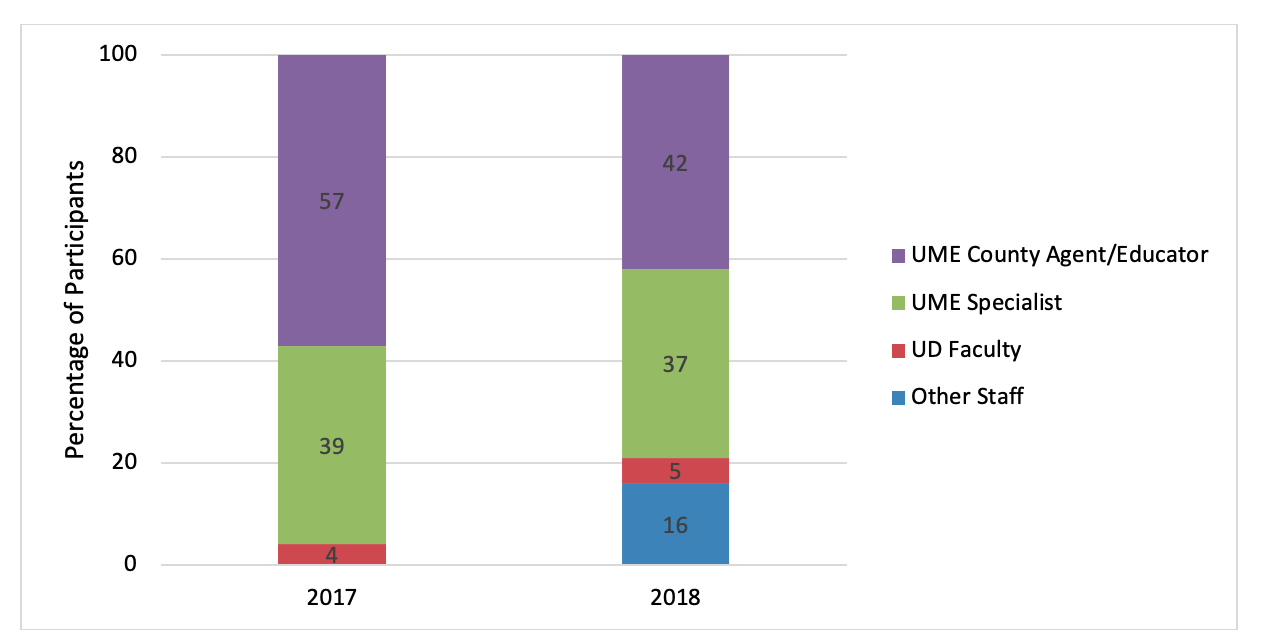
Note. UME = University of Maryland Extension; UD = University of Delaware.
A significant benefit of VPCs is the capacity to easily connect Extension field faculty and campus faculty on a monthly basis so that they can keep abreast of current growing conditions and production challenges faced in the field and exchange relevant information and knowledge. This benefit is reflected in the survey data. Top reasons respondents gave for attending the VPCs were to learn what others across the region were experiencing in the field and to learn more so that they could share new knowledge with others (Figure 3). Responses represented by "Other" in Figure 3 indicated that participants appreciated the photographs shared during the VPCs, which were "a powerful teaching tool" according to one respondent.
Figure 3.
Participants' Reasons for Attending Virtual Plant Clinics
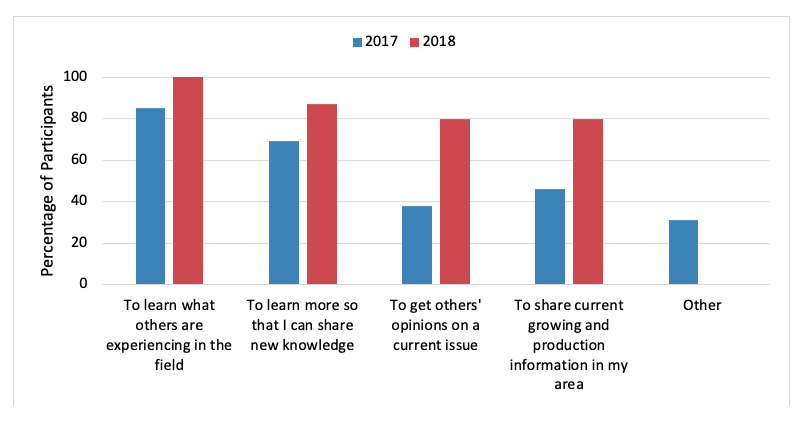
All participants reported increases in understanding of field conditions; knowledge of plant diseases, insects, and abiotic disorders; understanding of what is happening in other parts of the state; and communication among educators and specialists (Figure 4). Data also indicate that the distance-learning capability of the VPCs increases plant clinic participation over an in-person clinic (Figure 5) and that the majority of respondents wanted to see VPCs offered in the future.
Figure 4.
Increase in Knowledge or Understanding of Topics Discussed During Virtual Plant Clinics
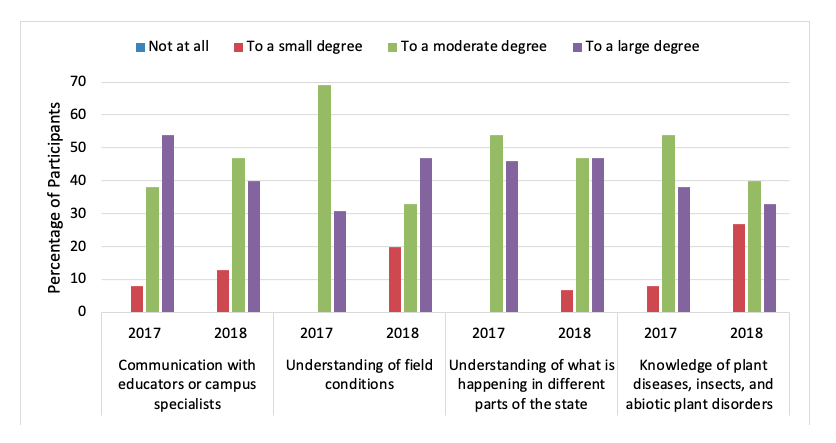
Figure 5.
Increase in Participation Resulting From Distance-Learning Format of Virtual Plant Clinics
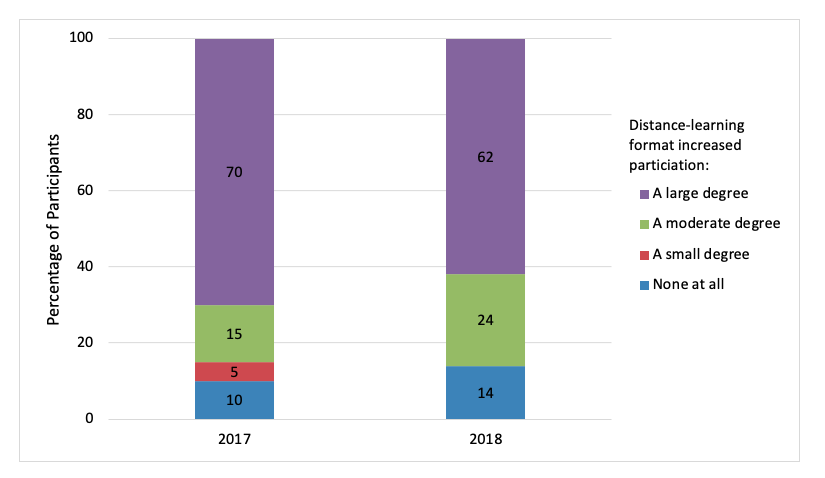
Recommendations
Survey data indicate that VPCs are a useful tool and can help Extension carry out its land-grant mission. Offering plant clinics on a virtual platform allows for increased participation, improves knowledge transfer, creates a more inclusive audience, and facilitates communication between faculty and staff from across a wide geographic region. Ultimately, the increase in communication and knowledge that is transferred through VPCs can help land-grant institutions better serve clients by reducing crop loss and saving farmers money. Furthermore, VPCs are relatively simple and inexpensive to implement in comparison to in-person clinics.
We suggest the following recommendations for implementing successful VPCs:
- Faculty members (or one faculty member) should lead the program. They schedule and coordinate the VPCs and facilitate organized discussions. They also save, upload, and archive the VPC recordings.
- An email invitation with Google Drive folder and conferencing platform links should be sent to university employees only.
- Photos in Google Drive should not be shared without permission. If permission is granted, proper attribution should occur.
- It should be made clear that unless confirmed prior to the VPC, photos are intended for discussion only and do not replace the need for formal diagnostics.
References
Ausher, R., Ben-Ze'ev, I. S., & Black, R. (1996). The role of plant clinics in plant disease diagnosis in developing countries. Annual Review of Phytopathology, 34, 51–66.
Aycock, R. (1976). The plant disease clinic—A thorn in the flesh, or a challenging responsibility. Annual Review of Phytopathology, 14, 165–175.
Barnes, L. W. (1994). The role of plant clinics in disease diagnosis and education: A North American perspective. Annual Review of Phytopathology, 32, 601–609.
Miller, S. A., Beed, F. D., & Harmon, C. L. (2009). Plant disease diagnostic capabilities and networks. Annual Review of Phytopathology, 47, 15–38. doi:10.1146/annurev-phyto-080508-081743
Oerke, E. C. (2006). Crop losses to pests. Journal of Agricultural Science, 144, 31–43. doi:10.1017/S0021859605005708.
Sobrero, P. M., & Craycraft, C. G. (2008). Virtual communities of practice: A 21st century method for learning, programming, and developing professionally. Journal of Extension, 46(5), Article 5FEA1. Available at: https://www.joe.org/joe/2008october/a1.php




